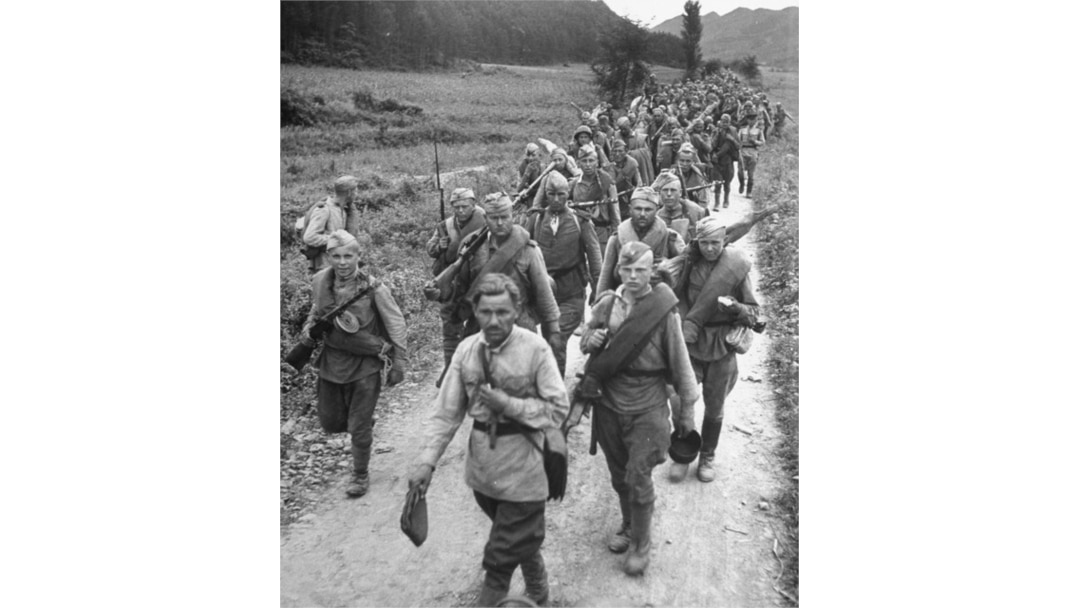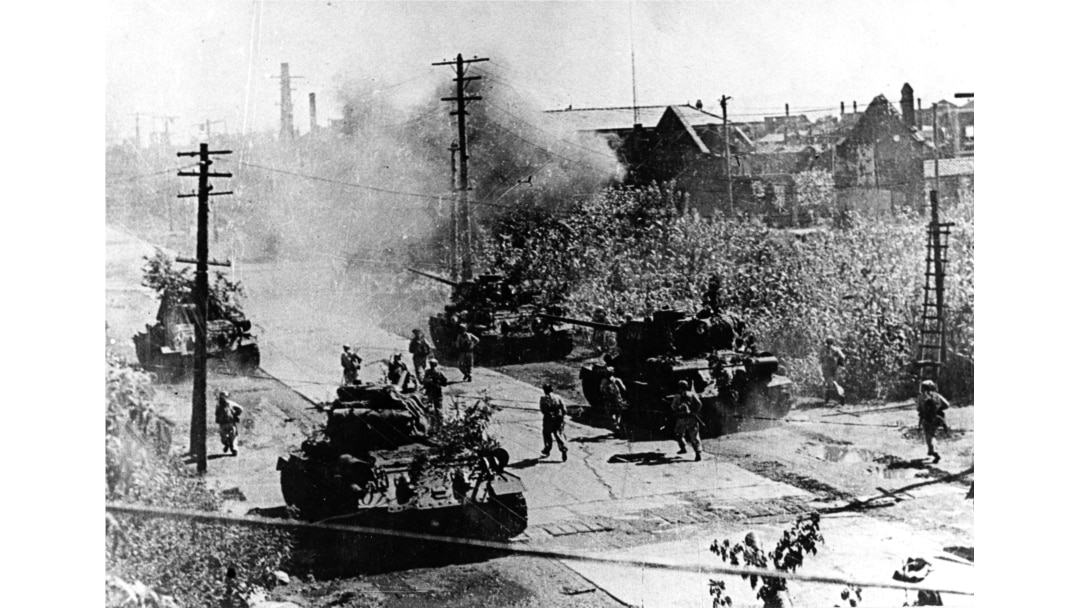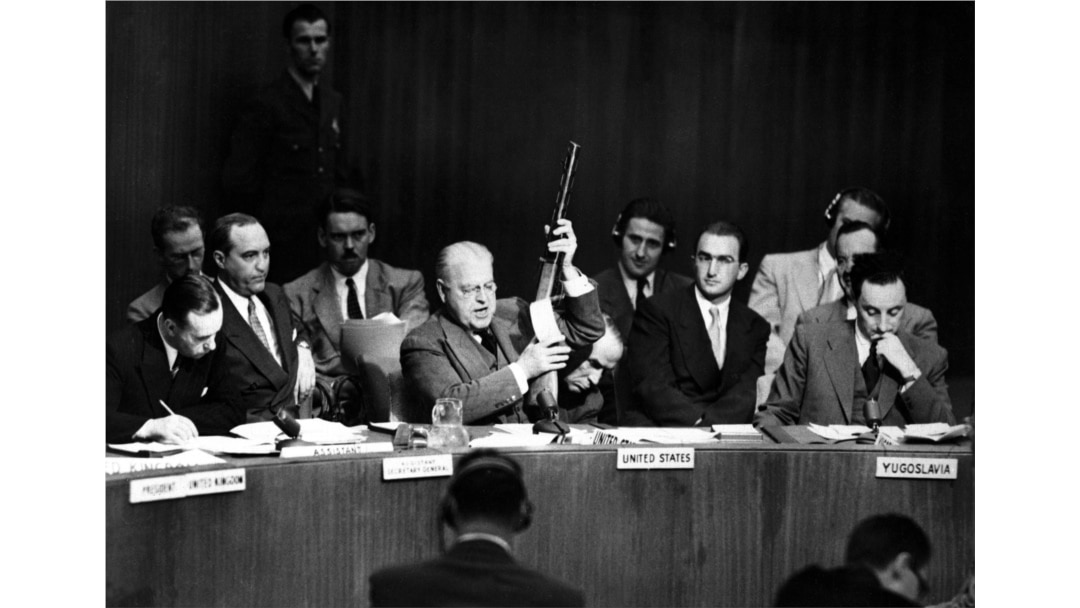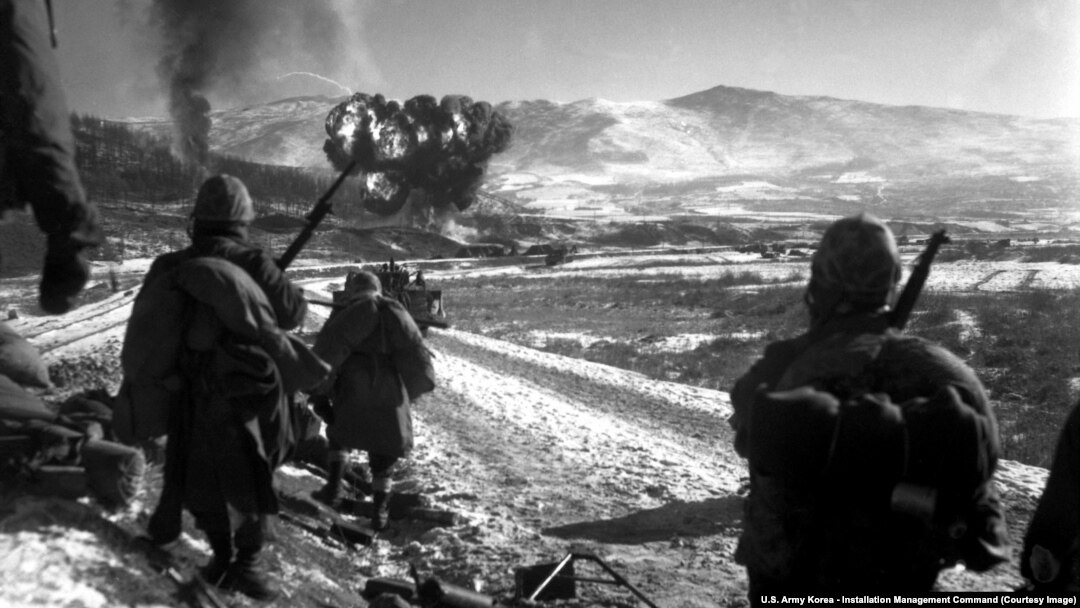At the close of World War II, the Korean Peninsula was occupied by Soviet troops in the north and U.S. forces in the south. The Soviet Union had declared war on Japan in August 1945 during the final days of World War II.

Soviet forces in Korea in 1945 after battling Japanese forces on the Korean Peninsula.
On June 25, 1950, after the two former allies left the peninsula, North Korea’s communist dictator Kim Il Sung launched an invasion across the 38th parallel in an attempt to seize South Korea and turn it into a communist state. Kim reportedly received the personal blessing of Josef Stalin to launch the shock invasion.

North Korean troops backed by Soviet-made tanks advance through Seoul in June 1950 a few days after the invasion began.
South Korea’s military quickly collapsed as thousands of communist fighters armed with Soviet PPSh “burp guns,” artillery, and T-34-85 tanks advanced south -- imposing a Korean version of Stalinism as they went.

Warren Austin, a U.S. delegate to the United Nations, holds a Soviet-made PPSh submachine gun, known as a “burp gun.” Captured by U.S. troops in Korea, it was displayed as evidence that Stalin was backing the invasion by communist forces.
With the world still haunted by the disaster of “appeasement” to Nazi aggression during the 1930s, the prospect of military intervention in Korea was initially popular.
A UN Security Council resolution passed by a vote of 7-1, with communist Yugoslavia against, called for the deployment of troops to “repel the armed attack [on South Korea] and to restore international peace and security to the area.”
U.S. soldiers arriving in Korea on July 1, 1950.
The “police action” backed by the UN began with a U.S. attempt to slow the southward advance of the communists.
The body of one of several U.S. soldiers who were executed after being captured by North Korean troops just south of Seoul in early July.
The first U.S. troops were vastly outnumbered and under-equipped. The men watched bitterly as most of their “anti-tank” weapons pinged harmlessly off the hulls of the advancing communist T-34s. In the first task force of 400 U.S. soldiers, 60 were killed and 82 were captured.
A grief-stricken U.S. soldier whose friend was killed in action is comforted by another infantryman in August 1950. In the background a corpsman fills out casualty tags.
Soon the relentless communist advance had pushed UN forces into the southeastern tip of Korea, where they took a stand at the so-called Pusan perimeter.
U.S. soldiers on the Pusan perimeter in 1950.
As the defensive line around Pusan held off waves of attacks by the overstretched North Koreans, massive reinforcements and supplies were shipped into the remaining nugget of UN-held territory.
Ethiopian troops arriving in Korea. Although the overwhelming number of troops were American, UN forces included more than a dozen different national contingents.
As autumn neared, U.S. General Douglas MacArthur ordered a risky seaborne assault on the port city of Inchon, hundreds of kilometers to the rear of the communist forces.
Troops and equipment being unloaded at Inchon on September 15, 1950.
The successful Inchon landing was a turning point in the war. UN troops were advancing on Seoul as communist forces desperately attempted to penetrate the UN line hundreds of kilometers to the south.
U.S. troops fighting in Seoul on September 20, 1950.
The bodies of some 400 Korean civilians murdered by the communists as they retreated from Taejon in September 1950. Witnesses said the victims were forced to dig their own trench graves before the killings.
Unfortunately for the optics of the UN intervention, South Korea’s U.S.-educated ruler, Syngman Rhee, was also known for corruption and summarily executing political prisoners.
A U.S. Marine with a painting of Soviet leader Josef Stalin found hanging in an abandoned North Korean bunker in November 1950.
Two boys who were serving in the North Korean Army are interrogated by a U.S. soldier on September 18, 1950.
Prisoners rounded up near a U.S. tank on September 26, 1950.
By October, the overwhelming firepower of the UN forces and the surprise of the Inchon landings had communist forces on the run.
A North Korean tank that was caught in an airstrike as it was crossing a bridge near Suwon on October 7, 1950.
UN forces soon drove the depleted communists back across the 38th parallel where North Korea’s military adventure had begun a few months earlier.
After fierce backroom debate over whether the drive of UN troops should be halted at the formal boundary between North and South Korea, Washington told its military leadership in Korea that “your military objective is the destruction of the North Korean armed forces…north of the 38th parallel.”
A U.S. warship hammers North Korean positions in Chong Jin, near North Korea’s border with China, on October 21, 1950. The UN had full control of the sea and dominated the skies.
But then, China secretly waded into the conflict by sending hundreds of thousands of lightly armed but highly experienced “volunteer” fighters into North Korea to lay in wait for the advancing UN forces.
An air strike hits a communist position in December 1950 as U.S. Marines look on.
In late 1950, the formidable Soviet MiG-15 fighter jets (pictured here in a 1963 file photo) appeared in the skies above North Korea. Many of the jets were flown by ace Soviet pilots who reportedly dressed in Chinese uniforms. The Kremlin consistently denied that Soviet pilots were involved in aerial combat above Korea, even as U.S. pilots heard them swearing in Russian over the radio during dogfights.
U.S. Marines after facing “a surprise onslaught by three Chinese communist divisions” in December 1950.
Faced with a massive, energized Chinese fighting force, UN troops were again forced to withdraw. As columns of troops and armor crawled south, they were attacked by Chinese troops who ghosted through the surrounding hills, prompting a U.S. general to famously describe the retreat as “just attacking in another direction.”
UN supplies destroyed by explosives at Hungnam, North Korea, after UN troops evacuated the port and withdrew.
UN troops and equipment float to Earth during a massive airdrop in 1951.
Then, after pulling out from North Korea, another wave of UN reinforcements was deployed in the south, helping to turn the tide of battle once more.
Chinese communist troops captured during fighting near Hoengsong, South Korea, in March 1951.
By the summer of 1951, leaders of countries in the war agreed to begin negotiations for an armistice.
U.S. Marines duck for cover as mortars burst near their trench.
But negotiations for peace progressed painfully slowly. At one point, the two delegations simply glared in silence across the table for two hours and 11 minutes. The fighting, and the immense suffering of the Korean people, continued as both sides used military strength to try to gain an advantage at the negotiating table.
Supply warehouses blasted into rubble in Wonsan, North Korea, by a U.S. air strike in 1951.
Finally, on July 27, 1953, the UN Command signed the Korean Armistice agreement that divided Korea loosely along the 38th parallel. No peace treaty has ever been signed, meaning the two Koreas technically remain at war.
A South Korean child sits alone on a street during fighting in Inchon in 1951.
The war cost the lives of an estimated 3 million people -- most of them Korean civilians, and largely wiped out most major cities on the Korean Peninsula.
A wounded U.S. soldier in 1950
According to the U.S. Department of Defense, the United States suffered 33,686 battle deaths – about 90 percent of the total losses among UN forces.
The Korean Peninsula photographed from space, showing the darkness of North Korea in the center of the image, and South Korea at the bottom right.
Seventy years on from the start of the Korean War, the North remains an impoverished totalitarian dictatorship, while the South is generally seen as one of the world’s most democratic and prosperous nations.


